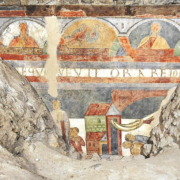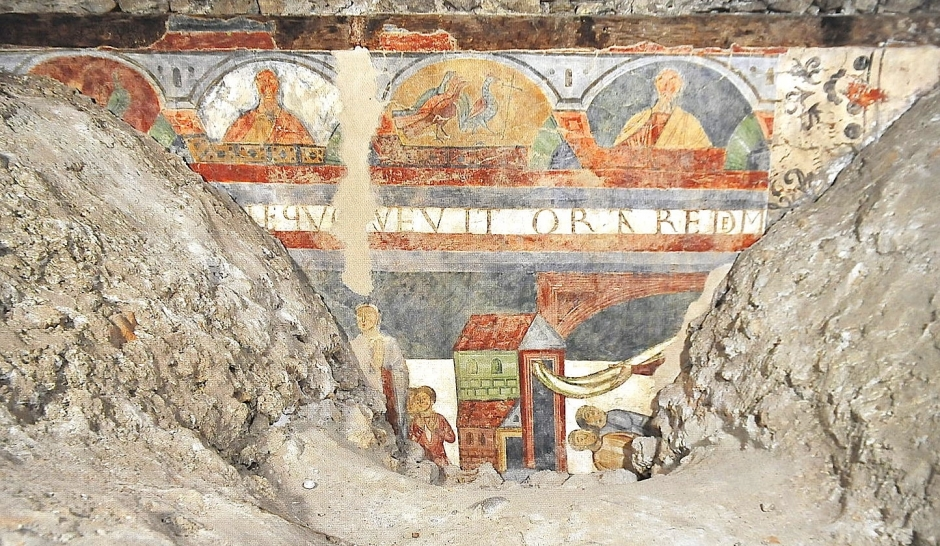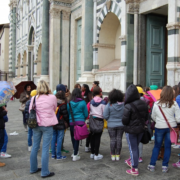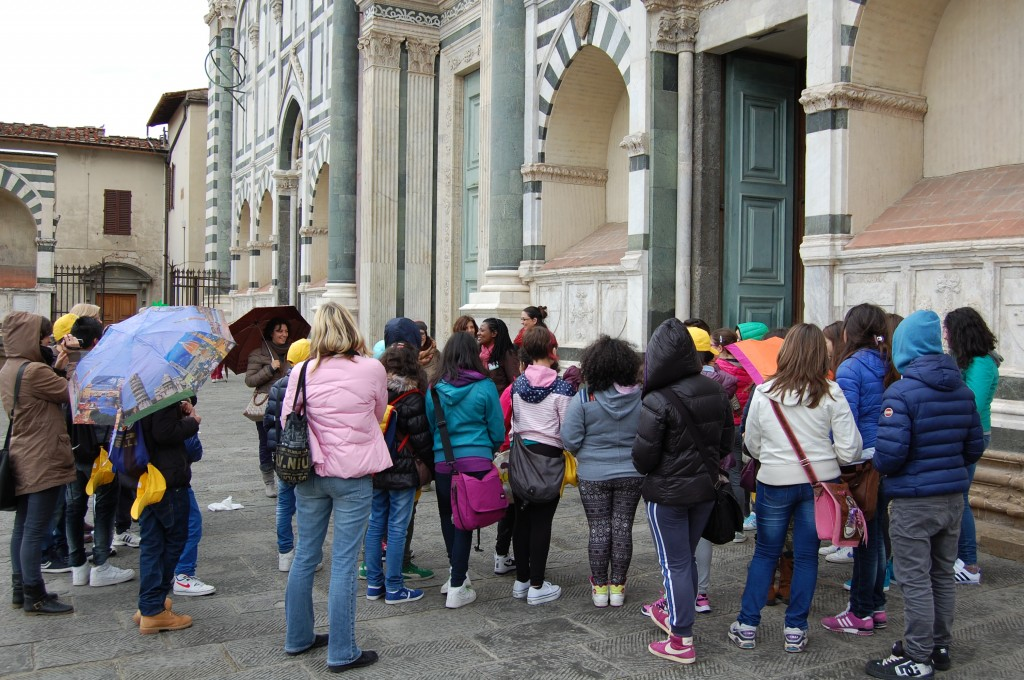Modern Restoration & the Renovated Crucifix in the Duomo of Crema
 At the risk of appearing obvious, it occurs to me that there are three categories of modern restoration which are effectively operative for paintings and sculptures:
At the risk of appearing obvious, it occurs to me that there are three categories of modern restoration which are effectively operative for paintings and sculptures:
(1) those for the art trade and private collectors
(2) those for museums and public collections
(3) those produced for a specific religious purpose, in churches and chapels.
In the first, the treatment of works destined for the art market, whether to be sold privately or at public auction, the art trade has certain demands and realities. Once an object finds its way into the hands of dealers, the tendency is to take considerable liberties in order to make it saleable. The dealers seem to know what their clients want, and they tend to give them exactly that. Very frequently, especially in the past, dealers actually did their own restorations, or at least had a restorer in-house who did them according to instructions. In such antiquarian restorations, the governing notion is to make the object as attractive as possible and, to be sure, authentic-looking.
The second category pertains to works in museums and public collections. Whether the institution is public in that it is controlled by a city, state or nation, or it belongs to a foundation, certain controls can be expected, at least in Europe where most nations have Art Ministries and Art Superintendencies with a certain level of jurisdiction. The operative goal in this category is the notion of “legibility.”
Third category, the one that concerns me in this essay, includes works which belong to religious entities and which continue to function as originally conceived, such as wall cycles with strong didactic overtones, or altarpieces with a current ceremonial and theological role.
As a parenthesis, another category can be constructed somewhere between the second and the third, as the church/museum is, in fact, reflective of the newest trend in Italy. Churches like Santa Maria del Carmine in Florence, for example, have a dual role, both to fulfil the needs of the faithful and to act as custodian for the Brancacci Chapel, with frescoes by Masaccio, Masolino, and Filippino Lippi. A decade ago, the chapel was transformed into a communal museum at the Carmine with a special entrance, and a prescribed path for viewing the various highlights including a quick visit to the Brancacci Chapel. I suspect those church members especially devoted to Saint Peter will have to do without the Brancacci.
Similar actions have occurred more recently across the Arno at Santa Maria Novella which is more generically a communal church/museum, with an entrance fee and those abominable electronic guides. Accommodations have been made for the faithful, but I suspect they should avoid looking at Masaccio’s recently restored Trinity, or risk the cost of the entrance fee. San Lorenzo in Florence has not one fee, but several: there is one to enter the main body of the church along with Brunelleschi’s unequalled Old Sacristy, another for the New Sacristy (which has long been a museum), and yet another for the Laurentian Library. One should not pick on Florence, however, since many churches in Venice operate under the same principle of the church/museum. In terms of restoration, the question of what is the appropriate mode for such an hybrid institution is particularly perplexing.
I seek here to consider only the third category in connection with an issue which was brought to my attention and which encapsulates a number of vital questions connected with modern art restoration theory and practice, especially in Italy. The object in question is a miraculous, over life-size, painted wood Crucifix which was created for and remains in the Duomo of Crema, a Lombard city not far from Milan. The work, of unknown authorship, probably dates to the 1340s and is neither of exceptional beauty nor is it significant by usual art-historical criteria. Nonetheless, a nexus of challenging issues can be related to it. They include two remarkable, not to say out-of-the-ordinary, characteristics: (1) a historical tradition which connects the Cross with the liberty of the city of Crema, giving it a civic quality; and (2) the tradition of the Cross as the subject of miracles. Especially relevant is the miraculous event which occurred during civic strife in 1448, when an evil man ran into the Duomo, grabbed the Cross and placed it on a fire on the main square. In order to avoid being scorched, the sculpted figure of Christ lifted his feet from the flames, an action which explains the fact that His feet are a few centimetres away from the wood plank to which He is attached.
The sculpture has accrued a black surface over the centuries whose origins are not known. The coloring does coincide with the tradition that it was in a fire, and that may explain this “iconographic” detail. Alternatively, the painted surface might reflect an effort to give the sculpture the look of being of bronze, which turns dark. In any case, the black surface has been a feature of the Cross known and revered by the faithful for centuries. How to deal with it has become the central issue for the current restoration (2000-2001). Should the old, traditional and revered – but not original – black be retained or should it be removed? If the object were housed in the Metropolitan Museum in Art in New York, or the Bargello in Florence, the answer would be much easier to achieve: it would have been removed without much thought. But the Cross is housed in the Duomo.
The situation surrounding the restoration of the Crema Cross has unexpected aspects. The restorer in charge, the Cremese Paolo Mariani has taken a position favoring a minimal intervention, supporting the retention of the black coating. The same view was originally expressed by the Bishop of Crema. The Soprintendente per i beni artistici e storici per le province di Brescia, Cremona e Mantova, with headquarters in Mantova and the authority over Crema, is ideologically on other side.
To complicate this case, the commission to carry out the restoration did not originate from the superintendency, but from the Bishop with the financial support of a local bank. In 1999 the Bishop sought a conservational restoration (“restauro conservativo”) of the Crucifix in conjunction the with Jubilee Year of 2000. Work on this object, most sacred in the hearts of the people of Crema, was handed over to the respected restorer, who is also a professor of restoration. He wanted to make the restoration open to the public at fixed times and was determined to undertake all possible tests to determine the physical condition of the work, including a TAC examination which was actually done at the local hospital. Basically Mariani sought to create a conservational intervention, without altering the traditional appearance of the Cross, thus to maintain what the people were used to seeing. His point of view was consistent with that of the Ufficio Beni Culturali of the Diocesi of Crema.
In contrast, the Soprintendente Dott. Giuliana Algeri intervened with a letter of 19 August 2000, insisting upon the removal of the black surface in order to “recover” the verist aspect of the original. The Soprintendente went on to describe her methodology, which included the “intuition [sic] that beneath there was antique painting which was confirmed by micro-stratagraphic study” (“intuizione che al di sotto ci fosse una dipintura antica che veniva confermata da indagini microstratigrafiche”). Besides she believed that the original painted surface – the one placed immediately on top of the priming layer of gesso and glue – could be found. And further it was expected to liberate further the surfaces in order to recover a chromatic aspect more compatible with the “epochal credibility of the polychromed sculpture” (“veridicta epocale della scultura policroma”). In these remarks we find the authoritarian rhetoric of official modern restoration.
The restorer was clearly in complete disagreement, asserting that “if one were to bring back to their original states all the artistic and architectural works of the past, eliminating all of the events which had occurred in the interim, Italy would be a country in which the works of art would be reduced to embryonic idols” (“se si dovessero riportare allo stato primitivo tutte le opere artistiche ed architettoniche del passato, eliminando tutti gli eventi che si sono materialmente sedimentati nel tempo, l’Ialia diverrebbe un paese nel quale le opere d’arte sarebbero ridotte a larvali feticci”). On a technical level, Mariani claims that what is regarded as original application of flesh tones is in actuality a coat that was applied after the fire of 1448, and not the fourteenth-century surface. But even this – let us call it the second surface – is highly incomplete. The original painting, which can occasionally be seen beneath this one, is present only in a minuscule percentage of the surface.
Notwithstanding his personal opinion, the restorer believed he was obliged, despite his philosophy and his intimate knowledge of the object, to follow the instructions of the Superintendency. He apparently felt that his knowledge and experience was such that it was better to continue to do the restoration rather than to be replaced, presumably by someone with less experience, and therefore salvage the salvageable.
Several conclusions can be reached in this case: (1) the Soprintendente has the final word on the treatment of art in her territory, which generally speaking is an important safeguard against whimsical, parochial interventions; (2) the Soprintendente was neither sympathetic nor aware of the distinctions between the different “kinds” of restorations listed at the beginning of this item and, perhaps unaware, she applied a museum standard; (3) the Soprintendente was much taken with the modern rhetoric of restorations regarding the recovery of ancient splendour, even when very little of it exists; and (4) the restorer, like many of his confreres, is caught in a unenviable situation to either follow the “orders” of the authorities or lose the job; Mariani seems to have chosen the course of inflicting the least possible damage to the work. Should he have refused to follow the instructions of the Soprintendente? My intuition is, probably.
The lesson, if there is one in this case, is that the system does not provide for any significant appeals over the authority of the Soprintendente. Should a system be created in which committees of disinterested individuals can, like a judge, weigh the evidence? Undoubtedly. Such a system would probably have prevented what is unfolding in Crema where the removal of the sacred, traditional aura is perpetrated in favor of a pseudo-ancient one.


 L’esito finale di una iniziativa messa in opera più di una decina di anni fà, quando allora c’era il signor Rollandin, Presidente della Regione, René Faval, Assessore alla Cultura, il Dr. Domenico Prola e Flaminia Montanari alla Soprintendenza delle Belle Arti, si é concrettizzata oggi con questi volumi che contenono gli atti del Convegno.
L’esito finale di una iniziativa messa in opera più di una decina di anni fà, quando allora c’era il signor Rollandin, Presidente della Regione, René Faval, Assessore alla Cultura, il Dr. Domenico Prola e Flaminia Montanari alla Soprintendenza delle Belle Arti, si é concrettizzata oggi con questi volumi che contenono gli atti del Convegno.
